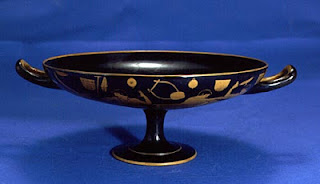The Kylix of Dionysus
While obviously Greek, many works like this kylix, also called Dionysus in a Boat, were ultimately discovered throughout Italy. Attributed to the painter Exekias, the character in the center is clearly Dionysus (Bacchus in Latin). This piece in particular was found in Etruria and is believed to have been completed around 530 BCE during the Archaic period of art in Greece.When looking at Roman and Greek art, one has to remember that there were no "tags" on the piece. Other than the common maneuver of directly writing a character's name, there would be no means of telling which characters are shown. Furthermore, a great deal of these people would be illiterate. For this reason, each god was given particular items with which to be shown. Dionysus, for example, would be recognized by grapes, being the god involved with drinking and wine. The story depicted was a common legend. Now transcribed in Ovid's Metamorphoses, this is the story describes an attempted kidnapping of this god. When still a boy, Dionysus asked a group of seamen to take him away from his birth island. The majority of the sailors wanted to kidnap him, and in mid-sail, he turned those unfaithful men into dolphins (depicted around the boat).
 |
| An example of a Kylix from the outside (not the same) |
http://www.perseus.tufts.edu/hopper/artifact?name=Munich+2044&object=Vase
http://www.cfa.arizona.edu/are130/files/greece.htm
http://www.bookrags.com/notes/met/PART19.html
http://www2.ocn.ne.jp/~greekart/vase/s_cup.html

No comments:
Post a Comment